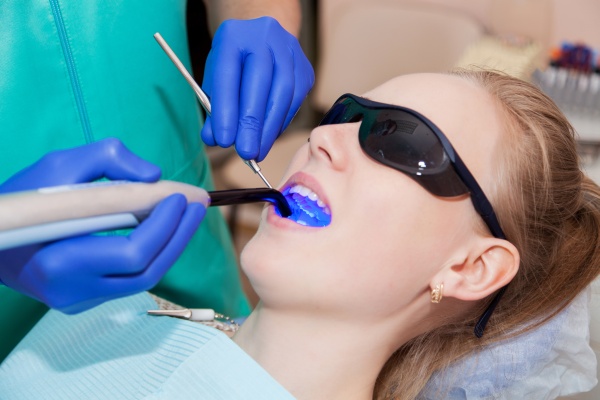In-Office Teeth Bleaching and Whitening: Are They the Same Thing?

With both teeth bleaching and teeth whitening being common terms, it can be confusing to understand the important differences. Both of these processes can be effective; however, they diverge on a few points. The methodology and chemistry of each vary, as do the results, which may vary depending on the severity and duration of the discoloration.
What causes teeth to become discolored and what are the options for treatment?
Teeth have a natural whiteness, but cola, strongly colored foods, coffee, tea, red wine and smoking all contain chemicals that can discolor the teeth. Certain medications can cause discoloration in the layers beneath the enamel. Bleaching and whitening can each improve the appearance of the teeth, but there are differences in how this is achieved.
What are the similarities between in-office teeth bleaching and whitening?
Both processes entail taking a mold of the teeth, from which trays are made. The flexible trays are fitted to every nook and cranny of tooth surfaces. This allows the brightening medium to sit closely next to the teeth. Once the custom trays are made, they are filled with a chemical gel that removes stains from the teeth.
What are the differences?
Whitening is a method that helps remove surface stains and discoloration caused by foods as well as some minor staining from tartar or plaque, both of which need to be removed by cleaning before the whiteners are used. Whitening removes and lightens the enamel surface of organic teeth, making it as close to their natural color as possible. Whiteners can be found in toothpaste, gum and mouthwash as well.
Bleaching, on the other hand, involves a stronger mixture containing either hydrogen or carbamide peroxide, chemicals that can penetrate beneath the surface of the tooth’s enamel. The peroxides enter the deeper levels of the teeth called dentin through minute fissures and microfractures that, over time, can also become stained by various means. The effect achieved by in-office teeth bleaching is often an extremely white smile, brighter than the natural tooth color.
Who is a candidate to receive either treatment?
Bleaching is a good option for those who have a history of drinking or eating the foods which enter the teeth and cause staining in the already more-yellowish dentin layer. Deep staining due to the use of certain medications or long-time food stains may also be relieved by bleaching. The level of whitening may be determined by the genetic color of a person’s dentin.
Whitening only removes staining from surface enamel. The teeth return to the teeth’s natural color. Bleaching not only brightens the enamel but also reaches more deeply into the dentin layer to remove the yellow discoloration that shows through the enamel.
Conclusion
For those whose self-esteem suffers because of stained and discolored teeth, teeth bleaching can be the answer. Cleaning not only the surface enamel but also deep into the yellow dentin layer, this process can reverse staining and add brighter level of whitening for a gleaming and more self-confident smile.
Request an appointment here: https://familychoicedentistry.com or call Family Choice Dental at (505) 634-5657 for an appointment in our Albuquerque office.
Check out what others are saying about our services on Yelp: Read our Yelp reviews.
Related Posts
Are you considering a smile makeover? Read on to learn more. A smile makeover has both cosmetic and emotional value. The psychological effects extend to one’s self-esteem and self-image. According to the American Academy of Cosmetic Dentistry, nearly 99.7% of individuals consider a smile an important social asset. Smiles have a high social value, and…
It is common to remove wisdom teeth for cosmetic and health reasons. A dentist has the knowledge and training to perform this procedure and determine whether you are a good candidate. These teeth usually come in by the time you reach your early 20s. Usually, you will have four of these teeth — two on…
If you have wisdom teeth coming in, it may be a good idea to talk to your dentist. Removing these teeth might be the right option so that you can avoid pain and discomfort. There often is not enough space for these teeth to grow in properly. This creates a host of concerns and health…
Smile makeovers are a blanket term for one or multiple procedures that help you achieve your dream smile. From adjusting the positions or replacing teeth to brightening or repairing them, smile makeovers can transform your teeth and self-confidence. Take a look at a few services typically offered to improve your smile.When the teeth shift, they…
